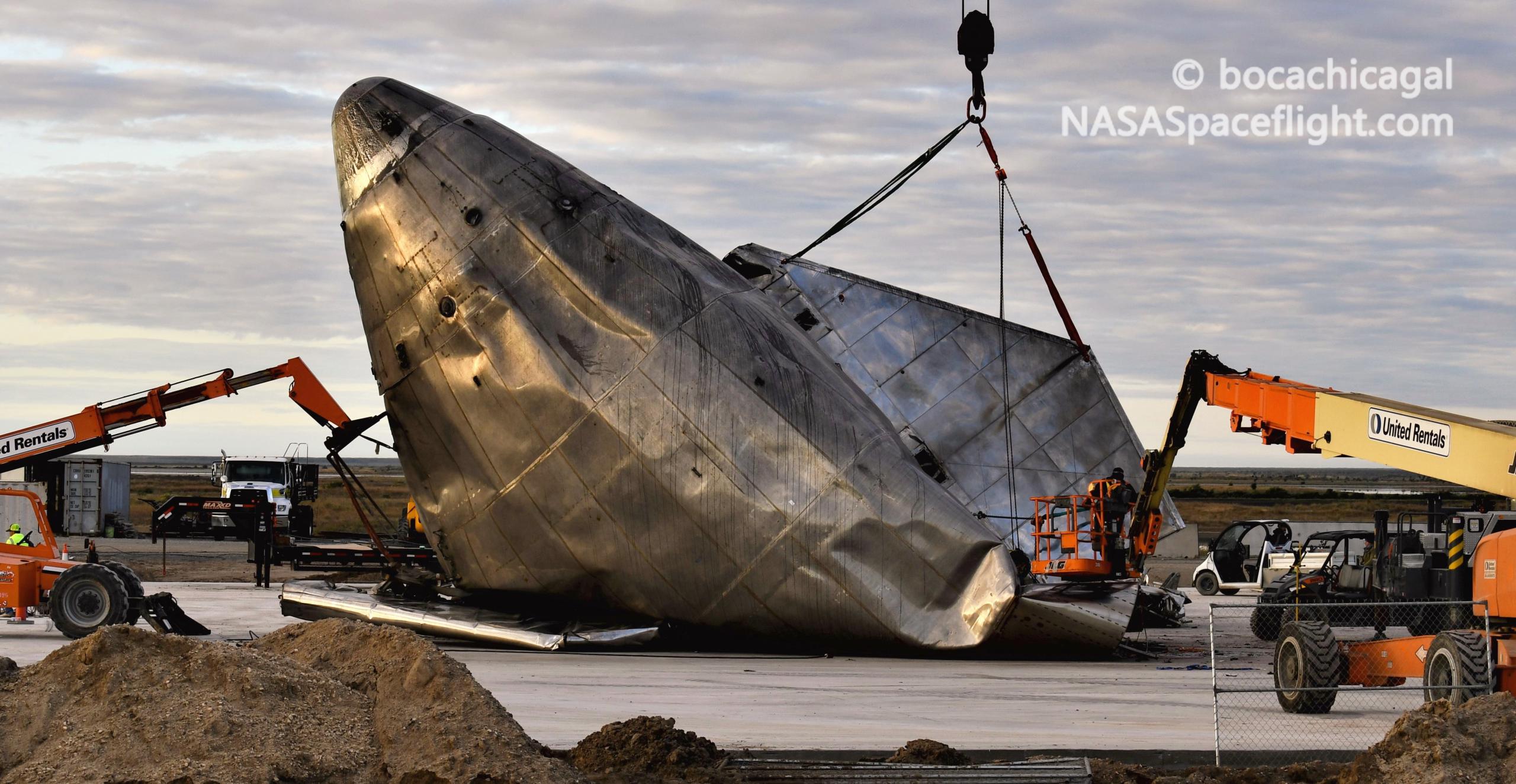

News
SpaceX scraps Starship SN8 wreckage, clears landing zone for next launch
In spite of tentative plans for preservation, SpaceX has fully scrapped the wreckage of the first high-altitude Starship prototype, clearing the landing zone it impacted for its successor’s imminent launch debut.
Known as serial number 8 or SN8, the Starship prototype was the first of any kind to fly beyond 150 meters (~500 ft), reaching an altitude of 12.5 km (~7.8 mi) on December 9th during its breathtaking launch debut. In an unexpected twist, SpaceX kept Starship SN8’s thrust to weight ratio as low as possible, stretching what could have been a two or three-minute test into an almost seven-minute ordeal with three consecutive Raptor engine cutoffs during the ascent.
At apogee, SN8 used cold gas thrusters to flip into a belly-down orientation and free-fell ~95% of the way back to Earth before igniting two of its three Raptor engines, performing a wild powered flip back into a vertical landing position and nearly securing a soft landing. Unfortunately, around 10-20 seconds before that planned landing, what Musk later described as low methane header tank pressure starved the Starship’s engines of fuel and more or less cut all appreciable thrust, causing SN8 to reach its landing zone traveling about 40 m/s (~90 mph) too fast. The rocket impacted the concrete pad, crumpled, and exploded.
By all accounts, success was one of the less likely outcomes SpaceX expected from SN8’s high-altitude debut, with Musk himself estimating the odds of total success to be just 33%. Additionally, Starship SN8 effectively made it all the way to a low-speed landing regime that Starships SN5 and SN6 all but flawlessly demonstrated with back-to-back 150m hops and landings in August and September 2020.
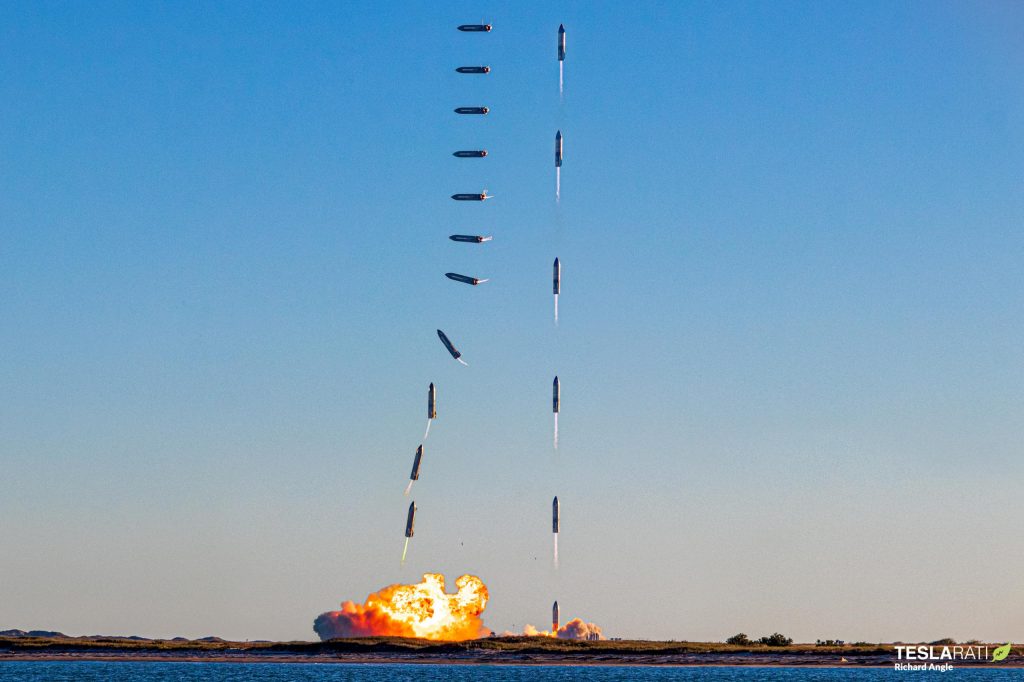
In other words, despite the explosive end, SN8’s high-altitude launch debut was a spectacular success for SpaceX’s Starship program – possibly even preferable to a perfect landing given that it uncovered an unexpected issue with fuel tank pressurization. Beyond the landing failure, the Starship checked every single box on SpaceX’s test flight list, successfully debuting multiple Raptors, demonstrating multiple in-flight engine shutdowns and engine relights; proving that an unprecedented ‘skydiver-style’ landing maneuver is possible and viable; and successfully testing Starship’s ability to control itself in that bellyflop orientation with thrusters and four massive flaps.
Speaking in a recent interview with Ars Technica, in the words of pragmatic SpaceX COO and President Gwynne Shotwell, SN8’s launch debut “de-risked [the Starship] program pretty massively.” According to Musk, SpaceX engineers were quickly able to determine why Starship SN8’s methane header tank was unable to maintain the fuel flow (pressure) needed for Raptor’s landing burn(s) and quickly implemented a solution.
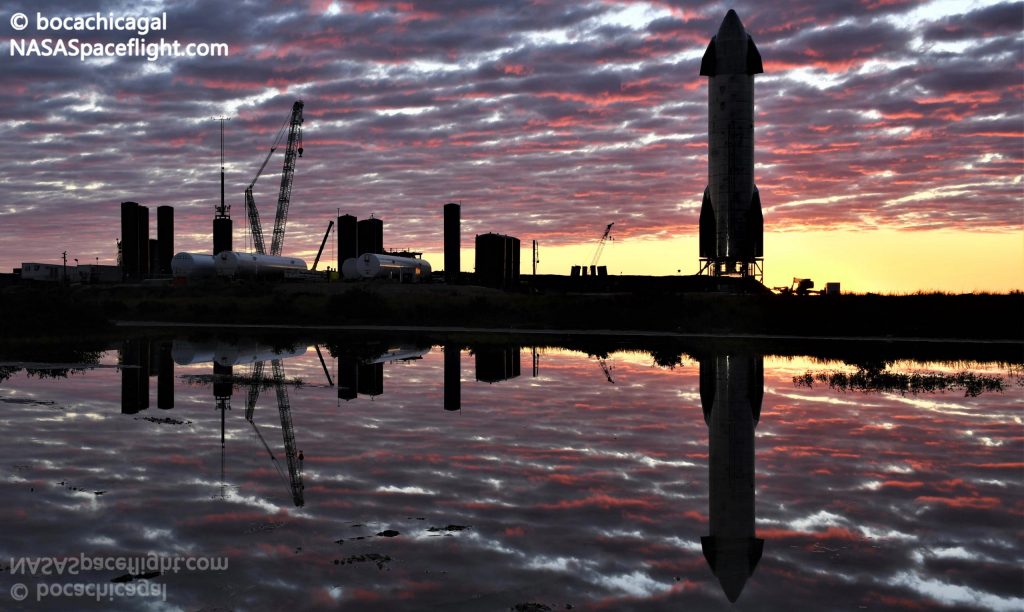
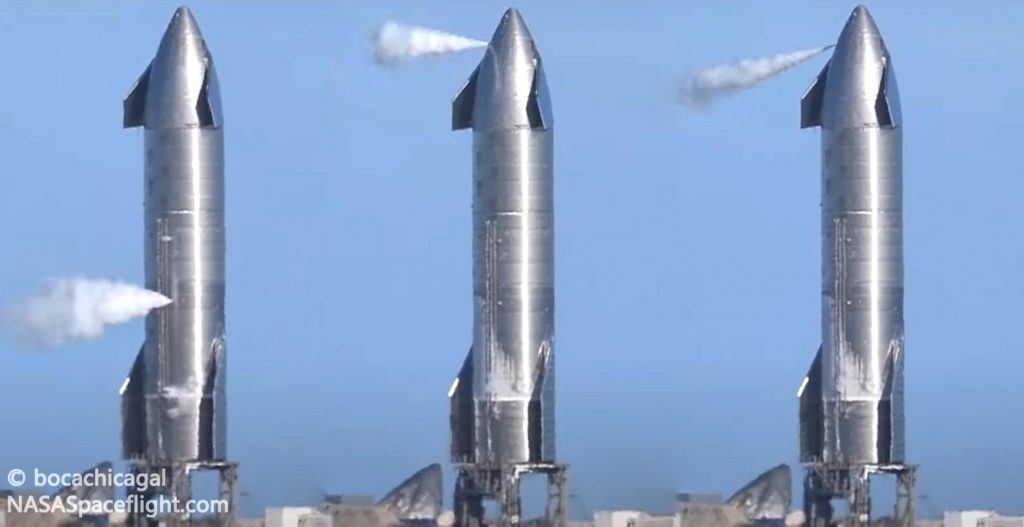
Instead of pressurizing autogenously with methane gas, Starship SN9 will use helium to pressurize its fuel header tank, serving as a temporary fix while SpaceX determines what changes need to be made to get rid of that helium crutch. Landing pad now cleared of Starship remains and SN8’s impact crater more or less repaired, the only thing standing between Starship SN9 and its own 12.5 km launch debut is a triple-Raptor static fire test. Originally expected as early as January 4th, SpaceX never made it more than a few minutes into the attempt, while a backup window on January 5th was canceled later that evening. The test could now occur no earlier than (NET) Wednesday, January 6th.
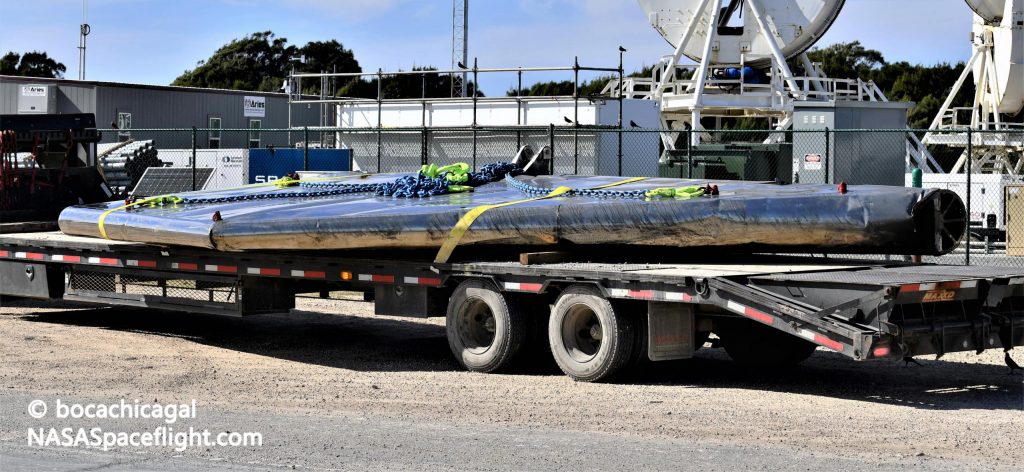
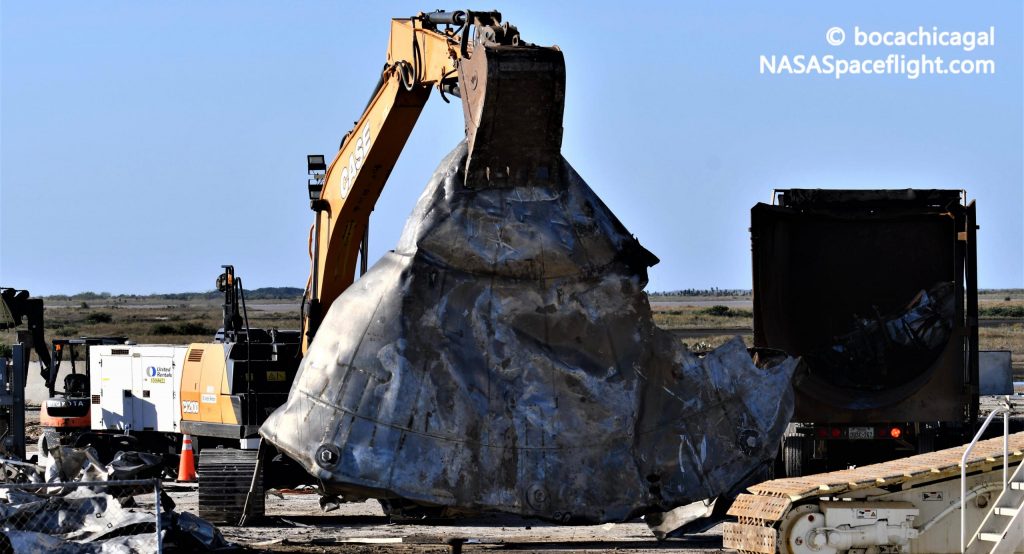
Thankfully, although SpaceX was unable to save the entirety of Starship SN8’s wrecked nose section, the company did manage to extract a largely intact nose flap. The rest of the remains were scrapped on site and trucked away but it’s possible that certain significant components of SN8 – particularly the recovered flap – will eventually find themselves on display at one or more SpaceX facilities.
Elon Musk
Tesla investors will be shocked by Jim Cramer’s latest assessment
Jim Cramer is now speaking positively about Tesla, especially in terms of its Robotaxi performance and its perception as a company.

Tesla investors will be shocked by analyst Jim Cramer’s latest assessment of the company.
When it comes to Tesla analysts, many of them are consistent. The bulls usually stay the bulls, and the bears usually stay the bears. The notable analysts on each side are Dan Ives and Adam Jonas for the bulls, and Gordon Johnson for the bears.
Jim Cramer is one analyst who does not necessarily fit this mold. Cramer, who hosts CNBC’s Mad Money, has switched his opinion on Tesla stock (NASDAQ: TSLA) many times.
He has been bullish, like he was when he said the stock was a “sleeping giant” two years ago, and he has been bearish, like he was when he said there was “nothing magnificent” about the company just a few months ago.
Now, he is back to being a bull.
Cramer’s comments were related to two key points: how NVIDIA CEO Jensen Huang describes Tesla after working closely with the Company through their transactions, and how it is not a car company, as well as the recent launch of the Robotaxi fleet.
Jensen Huang’s Tesla Narrative
Cramer says that the narrative on quarterly and annual deliveries is overblown, and those who continue to worry about Tesla’s performance on that metric are misled.
“It’s not a car company,” he said.
He went on to say that people like Huang speak highly of Tesla, and that should be enough to deter any true skepticism:
“I believe what Musk says cause Musk is working with Jensen and Jensen’s telling me what’s happening on the other side is pretty amazing.”
Tesla self-driving development gets huge compliment from NVIDIA CEO
Robotaxi Launch
Many media outlets are being extremely negative regarding the early rollout of Tesla’s Robotaxi platform in Austin, Texas.
There have been a handful of small issues, but nothing significant. Cramer says that humans make mistakes in vehicles too, yet, when Tesla’s test phase of the Robotaxi does it, it’s front page news and needs to be magnified.
He said:
“Look, I mean, drivers make mistakes all the time. Why should we hold Tesla to a standard where there can be no mistakes?”
It’s refreshing to hear Cramer speak logically about the Robotaxi fleet, as Tesla has taken every measure to ensure there are no mishaps. There are safety monitors in the passenger seat, and the area of travel is limited, confined to a small number of people.
Tesla is still improving and hopes to remove teleoperators and safety monitors slowly, as CEO Elon Musk said more freedom could be granted within one or two months.
News
Tesla launches ultra-fast V4 Superchargers in China for the first time
Tesla has V4 Superchargers rolling out in China for the first time.

Tesla already has nearly 12,000 Supercharger piles across mainland China. However, the company just initiated the rollout of the ultra-fast V4 Superchargers in China for the first time, bringing its quick-charging piles to the country for the first time since their launch last year.
The first batch of V4 Superchargers is now officially up and running in China, the company announced in a post on Chinese social media outlet Weibo today.
The company said in the post:
“The first batch of Tesla V4 Superchargers are online. Covering more service areas, high-speed charging is more convenient, and six-layer powerful protection such as rain and waterproof makes charging very safe. Simultaneously open to non-Tesla vehicles, and other brands of vehicles can also be charged. There are more than 70,000 Tesla Superchargers worldwide. The charging network layout covers 100% of the provincial capitals and municipalities in mainland China. More V4 Superchargers will be put into use across the country. Optimize the charging experience and improve energy replenishment efficiency. Tesla will accompany you to the mountains, rivers, lakes, and seas with pure electricity!”
The first V4 Superchargers Tesla installed in China are available in four cities across the country: Shanghai, Zhejiang, Gansu, and Chongqing.

Credit: Tesla China
Tesla has over 70,000 Superchargers worldwide. It is the most expansive and robust EV charging network in the world. It’s the main reason why so many companies have chosen to adopt Tesla’s charging connector in North America and Europe.
In China, some EVs can use Tesla Superchargers as well.
The V4 Supercharger is capable of charging vehicles at speeds of up to 325kW for vehicles in North America. This equates to over 1,000 miles per hour of charging.
Elon Musk
Elon Musk hints at when Tesla could reduce Safety Monitors from Robotaxi
Tesla could be reducing Safety Monitors from Robotaxi within ‘a month or two,’ CEO Elon Musk says.

Elon Musk hinted at when Tesla could begin reducing Safety Monitors from its Robotaxis. Safety Monitors are Tesla employees who sit in the front passenger seat during the driverless rides, and are there to ensure safety for occupants during the earliest rides.
Tesla launched its Robotaxi fleet in Austin last Sunday, and after eight days, videos and reviews from those who have ridden in the driverless vehicles have shown that the suite is safe, accurate, and well coordinated. However, there have been a few hiccups, but nothing that has put anyone’s safety in danger.
A vast majority — close to all of the rides — at least according to those who have ridden in the Robotaxi, have been performed without any real need for human intervention. We reported on what was the first intervention last week, as a Safety Monitor had to step in and stop the vehicle in a strange interaction with a UPS truck.
Watch the first true Tesla Robotaxi intervention by safety monitor
The Tesla and UPS delivery truck were going for the same street parking space, and the Tesla began to turn into it. The UPS driver parallel parked into the spot, which was much smaller than his truck. It seemed to be more of an instance of human error instead of the Robotaxi making the wrong move. This is something that the driverless cars will have to deal with because humans are aggressive and sometimes make moves they should not.
The Safety Monitors have not been too active in the vehicles. After all, we’ve only seen that single instance of an intervention. There was also an issue with the sun, when the Tesla braked abnormally due to the glare, but this was an instance where the car handled the scenario and proceeded normally.
With the Robotaxi fleet operating impressively, some are wondering when Tesla will begin scaling back both the Safety Monitors and Teleoperators that it is using to ensure safety with these early rides.
CEO Elon Musk answered the inquiry by stating, “As soon as we feel it is safe to do so. Probably within a month or two.”
As soon as we feel it is safe to do so.
Probably within a month or two. We continue to improve the Tesla AI with each mile driven.
— Elon Musk (@elonmusk) June 30, 2025
Musk’s response seems to confirm that there will be fewer Teleoperators and Safety Monitors in the coming months, but there will still be some within the fleet to ensure safety. Eventually, that number will get to zero.
Reaching a point where Tesla’s Robotaxi is driverless will be another significant milestone for the company and its path to fully autonomous ride-sharing.
Eventually, Tesla will roll out these capabilities to consumer-owned vehicles, offering them a path to generate revenue as their car operates autonomously and completes rides.
For now, Tesla is focusing on perfecting the area of Austin where it is currently offering driverless rides for just $4.20 to a small group of people.
-

 News5 days ago
News5 days agoTesla Robotaxi’s biggest challenge seems to be this one thing
-

 News2 weeks ago
News2 weeks agoTesla confirms massive hardware change for autonomy improvement
-

 Elon Musk2 weeks ago
Elon Musk2 weeks agoElon Musk slams Bloomberg’s shocking xAI cash burn claims
-

 News2 weeks ago
News2 weeks agoTesla China roars back with highest vehicle registrations this Q2 so far
-

 News2 weeks ago
News2 weeks agoTesla features used to flunk 16-year-old’s driver license test
-

 News2 weeks ago
News2 weeks agoTesla dominates Cars.com’s Made in America Index with clean sweep
-

 News2 weeks ago
News2 weeks agoTexas lawmakers urge Tesla to delay Austin robotaxi launch to September
-

 News2 weeks ago
News2 weeks agoTesla’s Grok integration will be more realistic with this cool feature





















